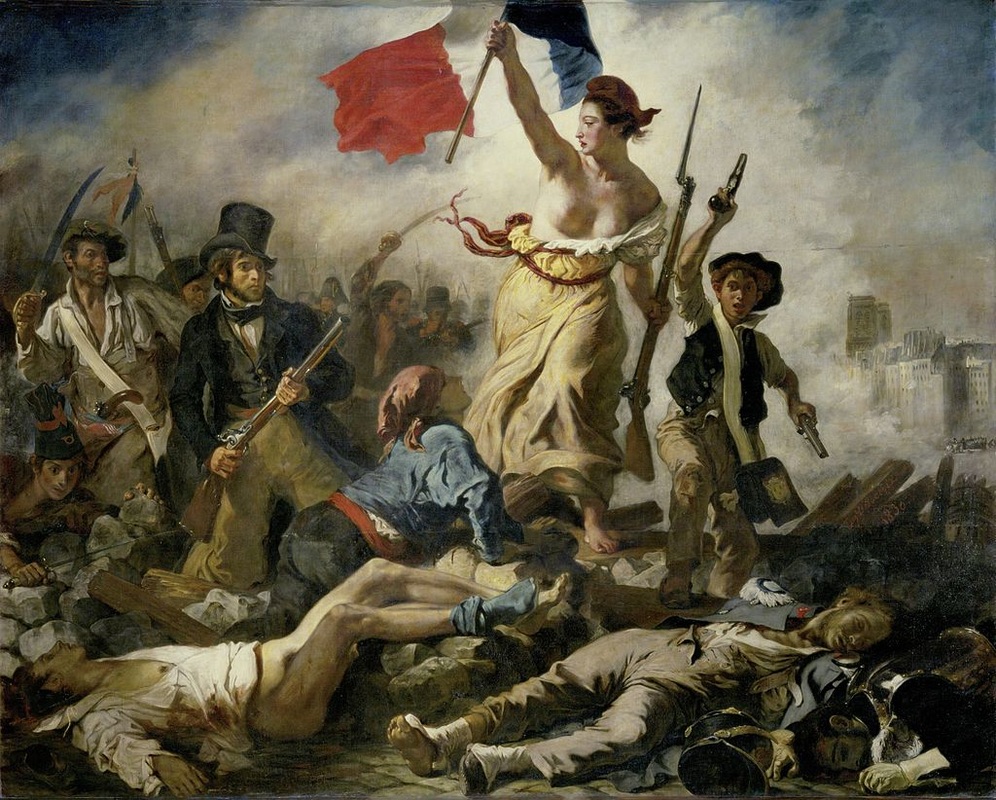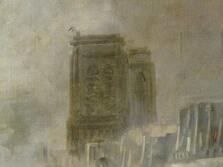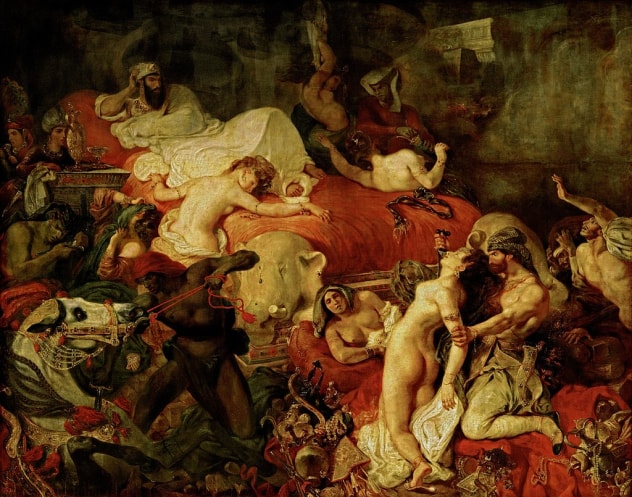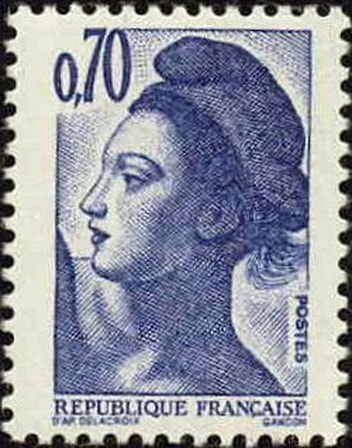|
Where? First floor, room 700 of the Denon wing in the Louvre
When? 1830 What do you see? This painting represents what a revolution feels like for the people involved. The woman in the center, referred to as Liberty, is holding the French tricolor. She stands on top of a barricade, which you can recognize by the pieces of wood and the cobblestones in the foreground. Liberty represents the struggle of the common people for freedom, but at the same time, she shows the energy and excitement that was part of a revolution. In her left hand, she holds an infantry musket. This is a rifle with a bayonet fixed to it, in case she needed to spear an enemy from close range. Liberty is depicted in a victorious pose, and she is showing her breasts to the people. Liberty is surrounded by a mix of people from the French society. On her right is a child brandishing a pair of guns. At her feet is a day laborer from the countryside wearing a blue jacket (notice the red, white, and blue pattern in his clothes, resembling the French flag). The man to Liberty’s left, with the black jacket and the top hat, is represents the middle-class people (some say it is Delacroix himself, but there is serious doubt about this claim). The man in white on the left is a factory worker holding a saber. There is a sharp contrast between the victorious people fighting for the freedom of France and the dead people in the foreground. In the bottom right, you can see a dead soldier and a guardsman. In the background, you can see the smoke of the cannons. In the top right background, the city of Paris is visible with the two iconic towers of the Notre Dame. Finally, the two spars of wood on the right show the signature of the painter, reading “Eug. Delacroix 1830.”
Backstory: This painting commemorates the July Revolution of 1830 in France. During this revolution, King Charles X of France was brought down. Delacroix wrote in a letter to his brother that if he could not fight for his country, he could at least paint for France.
This painting served as a political poster for the revolution, and the idea was that people would sympathize with the freedom fighters in this painting. It took Delacroix about two months to complete the painting. The next he year he sold the painting to the government for three thousand French francs. In addition, they awarded him the Legion of Honour, the highest French order for merits by military and civilians which was introduced by Napoleon Bonaparte. July Revolution: After Napoleon Bonaparte was defeated in 1815, the monarchy was restored in France. On July 25, 1830, King Charles X signed four public announcements that were unfavorable to the common people. These announcements included the end of press freedom and a new voting system that favored the higher classes in society. On July 27, 1830, the citizens of Paris started the July revolution (also called the Second French Revolution) against King Charles X. The civil war lasted three days, and on August 2, 1830, Charles X officially abdicated. His successor was Louis-Philippe, the cousin of Charles X, who became the new king (until he was brought down in the Third French Revolution of1848).
The different caps in this painting are representative of the different social classes that participated in the revolution. Do you see the simple hat of the factory worker on the left, the infantry hat of the young man below him who is holding on to the cobblestones, the top hat of the middle class, the cloth of the day laborer at Liberty’s feet, and the student hat of the boy on the right?
The red cap that Liberty wears on her head is also a symbol of liberty. It is a Phrygian cap, which is a soft cap in the form of a cone with the top pulled forward. The Phrygian cap is also called the liberty cap as, especially in artistic works, it represents freedom. This cap was popular during the first French Revolution between 1789 and 1799.
Romanticism? Eugène Delacroix is considered to be the father of French Romantic painting. At the beginning of the 19th century, there was an ongoing debate between Delacroix and Jean-Auguste-Dominique Ingres on the best style of painting. Ingres, who is considered to be a Neoclassical painter, believed in the classical ideas such as simplicity, symmetry, and idealized beauty in art. However, Delacroix thought that the expressive potential of colors was much more important. He liked to depict moments of extreme emotions as you can see in this painting.
Who is Eugène Delacroix? Eugène Delacroix (1798-1863) was born in a small village close to Paris. He has made many large-scale paintings about contemporary subjects, which was a successful strategy to earn money around that time. His work was usually dramatic and romantic, and he knew how to express emotions in a painting. He was inspired by artists such as Titian and Rubens and is considered to be the father of French Romanticism. He was a very productive artist, and after his death, 9,140 works were attributed to him, mostly drawings but also 853 paintings. Many other French artists have been inspired by the works of Delacroix, including Degas, Manet, and Renoir. Another famous work by Delacroix, also in the Louvre, is The Death of Sardanapalus.
0 Comments
Leave a Reply. |
Categories
All
|
- Home
- Blog
-
Museums
- Alte Pinakothek
- Art Institute of Chicago
- Baltimore Museum of Art
- Barber Institute of Fine Arts
- Bargello
- Barnes Foundation
- British Museum
- Church of Sant’Anastasia
- Cleveland Museum of Art
- Courtauld Institute of Art
- Detroit Institute of Arts
- Frans Hals Museum
- Galleria Borghese
- Gallerie dell'Accademia
- Getty Museum
- Guggenheim
- Hermitage Museum
- Kunsthistorisches Museum
- Kunstmuseum Basel
- Legion of Honor Museum
- Louvre
- Mauritshuis
- Metropolitan Museum of Art
- Musee d’Orsay
- Museum of Fine Arts in Boston
- Museum of Modern Art
- National Gallery in London
- National Gallery of Art
- National Museum in Poznań
- Norton Simon Museum
- Ny Carlsberg Glyptotek
- Palace of Versailles
- Palazzo Pitti
- Palazzo Vecchio
- Petit Palais
- Philadelphia Museum of Art
- Prado
- Pushkin Museum
- Ravenna Art Museum
- Rijksmuseum
- San Diego Museum of Art
- Santa Maria delle Grazie
- St. Peter's Basilica
- Städel Museum
- Statens Museum for Kunst
- Tate Britain
- Tate Modern
- Timken Museum of Art
- Uffizi
- Vatican Museums
- Wallace Collection
-
Artists
- Altdorfer
- Anguissola
- Berlin Painter
- Bosch
- Botticelli
- Boucher
- Bronzino
- Bruegel the Elder
- Brunelleschi
- Cabanel
- Caillebotte
- Canova
- Caravaggio
- Carpeaux
- Cezanne
- Cimabue
- David
- Degas
- Delacroix
- De Maria
- Donatello
- El Greco
- Fontana
- Fra Angelico
- Fragonard
- Gauguin
- Gentileschi
- Gericault
- Gonzalez-Torres
- Goya
- Hals
- Hogarth
- Hokusai
- Ingres
- Leonardo da Vinci
- Lippi, Filippo
- Longhi, Barbara
- Lorrain
- Makovsky
- Manet
- Massys
- Matisse
- Merian
- Michelangelo
- Mochi
- Modigliani
- Monet
- Panini
- Parmigianino
- Perugino
- Picasso
- Pisanello
- Raphael
- Rembrandt
- Renoir
- Reynolds
- Rivera
- Rodin
- Rubens
- Scultori
- Seurat
- Steen
- Tintoretto
- Titian
- Toulouse-Lautrec
- Turner
- Uccello
- Van der Weyden
- Van Dyck
- Van Eyck
- Van Gogh
- Van Hemessen
- Vasari
- Velazquez
- Vermeer
- Veronese
- Vigée Le Brun
-
Locations
- Books
- About Us




